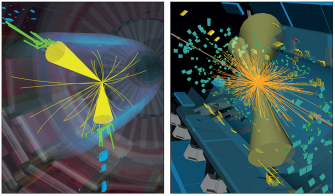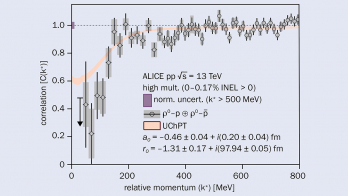The LHCb collaboration has added four new exotic particles to the growing list of hadrons discovered so far at the LHC. In a paper posted to the arXiv preprint server yesterday the collaboration reports the observation of two tetraquarks with a new quark content (cc̄us̄): a narrow one, Zcs(4000)+, and a broader one Zcs(4220)+. Two other new tetraquarks, X(4685) and X(4630), with a quark content cc̄ss̄, were also observed. The results, which emerged thanks to adding the statistical power from LHC Run 2 to previous datasets, follow four tetraquarks discovered by the collaboration in 2016 and provide grist for the mill of theorists seeking to explain the nature of tetraquark binding mechanisms.

The new exotic states were observed in an almost pure sample of 24 thousand B+→J/ψφK+ decays, which, as a three-body decay, may be visualised using a Dalitz plot (see “Mountain ridges” figure). Horizontal and vertical bands indicate the temporary production of tetraquark resonances which subsequently decay to a J/ψ meson and a K+ meson or a J/ψ meson and a φ meson, respectively. The most prominent vertical bands correspond to the cc̄ss̄ tetraquarks X(4140), X(4274), X(4500) and X(4700) which were first observed in June 2016. The collaboration has now resolved two new horizontal bands corresponding to the cc̄us̄ states Zcs(4000)+ and Zcs(4220)+, and two additional vertical bands corresponding to the cc̄ss̄ states X(4685) and X(4630).
These states may have very different inner structures
Liming Zhang
The results have already triggered theoretical head scratching. In November, the BESIII collaboration at the Beijing Electron–Positron Collider II reported the discovery of the first candidate for a charged hidden-charm tetraquark with strangeness, tentatively dubbed Zcs(3985)– (CERN Courier January/February 2021 p12). It is unclear whether the new Zcs(4000)+ tetraquark can be identified with this state, say physicists. Though their masses are consistent, the width of the BESIII particle is ten times smaller. “These states may have very different inner structures,” says lead analyst Liming Zhang of the LHCb collaboration. “The one seen by BESIII is a narrow and longer-lived particle, and is easier to understand with a nuclear-like hadronic molecular picture, where two hadrons interact via a residual strong force. The one we observed is much broader, which would make it more natural to interpret as a compact multiquark candidate.”

59 hadrons
The new observations take the tally of new hadronic states discovered at the LHC – which includes several pentaquarks as well as rare and excited mesons and baryons – to 59 (see “Diagram of discovery” figure). Though quantum chromodynamics naturally allows the existence of states beyond conventional two- and three-quark mesons and baryons, the detailed mechanisms responsible for binding multi-quark states are still largely mysterious. Tetraquarks, for example, could be tightly bound pairs of diquarks or loosely bound meson-meson molecules – or even both, depending on the production process.
Who would have guessed we’d find so many exotic hadrons?
Patrick Koppenburg
“Who would have guessed we’d find so many exotic hadrons?” says former LHCb physics coordinator Patrick Koppenburg, who put the plot together. “I hope that they bring us to a better modelling of the strong interaction, which is very much needed to understand, for instance, the anomalies we see in B-meson decays.”
Further reading
LHCb Collaboration 2021 arXiv:2103.01803









